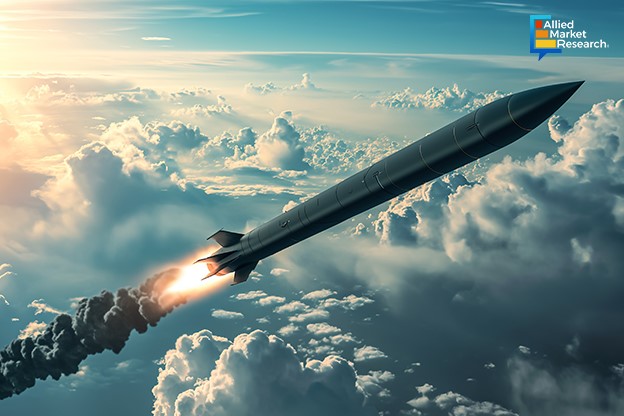How Are Hypersonic Missiles Contributing to Military Modernization?

15 May
2024
Highlights
- Introduction
- Advanced technologies in hypersonic missiles
- Expansion of the Asia-Pacific hypersonic missile sector
- Recent developments in the industry
A hypersonic missile is designed to travel at five times the speed of sound in the Earth's atmosphere. These missiles excel in agility and target acquisition, allowing them to strike distant targets effectively within a short timeframe. When paired with appropriate guidance systems, hypersonic missiles are utilized for precise strikes targeting critical, stationary sites like command-and-control centers or fortified bunkers. Additionally, they engage time-sensitive mobile targets such as maritime vessels.
The global hypersonic missile industry is expanding rapidly due to an increasing interest from military entities in adopting hypersonic systems. The surging demand for hypersonic missiles and associated technologies to improve military abilities is expected to fuel industry growth.
Analyzing technological advancements optimizing the potential of hypersonic missiles
Several nations are prioritizing investment in hypersonic technologies to fuel their military modernization initiatives. The deployment of hypersonic missiles and vehicles offers strategic advantages, enhancing precision strike abilities, deterring potential threats, and strengthening defense mechanisms against emerging challenges. Heightened research and development expenditures have played a pivotal role in expanding the sector of hypersonic missiles. Furthermore, progress in propulsion systems, materials science, manufacturing techniques, and aerodynamics has increased the feasibility of developing these devices.
One of the advanced technologies highly used in hypersonic missiles is scramjet propulsion. Scramjets are air-breathing engines that draw in atmospheric air for combustion, eliminating the necessity of carrying onboard oxidizers. This makes the system much lighter, more efficient, and cost-effective compared to rocket engines. In contrast to conventional jet engines, scramjets do not incorporate rotating components such as compressors and turbines. Instead, scramjets utilize the aerodynamic configuration of the engine to compress incoming air. This streamlined approach simplifies the design and minimizes maintenance needs.
Growing landscape of the Asia-Pacific hypersonic missile industry
The demand for advanced hypersonic technologies in the Asia-Pacific region is escalating due to ongoing territorial disputes and military modernization initiatives. Additionally, China and Russia have made advancements in cultivating domestic hypersonic abilities. This includes progress in propulsion systems, materials science, and guidance technology, enabling the production of hypersonic missiles, glide vehicles, and boost-glide vehicles. Among the emerging economies in the Asia-Pacific region, India is estimated to cite a noteworthy CAGR of 8.6% by 2031.
Alliances by frontrunners to maintain supremacy in the evolving sector
Top entities in the global hypersonic missile industry are adopting novel strategies to dominate the competitive sector. For instance, BAE Systems made investments in Australia via its subsidiary BAE Systems Australia in May 2021 to accelerate the establishment of a sovereign high-speed weapons ability, particularly in hypersonic weapons. Over the past decade, it has allocated over $11 million towards research in hypersonic and high-speed weaponry in collaboration with defense industry partners and academic institutions.
Moreover, Raytheon, in collaboration with Northrop Grumman Corporation, successfully secured a contract from the Defense Advanced Research Projects Agency (DARPA) in July 2023 to develop air-breathing hypersonic systems. This partnership has fueled the development and flight testing of additional HAWC (Hypersonic Air-breathing Weapon Concept) vehicles by providing increased capabilities and boosted system validation.
In April 2024, CoAspire and Lockheed Martin introduced the new Mako Multi-Mission Hypersonic Missile at the event: Sea Air Space 2024. This missile is fast, easily targets multiple objectives, and cost-effective.
To sum up, advanced technologies such as scramjet propulsion have enhanced the proficiency and precision of hypersonic missiles. Moreover, geopolitical tensions and military modernization in Asia-Pacific are accelerating the growth of the industry in this region. The advancements in scramjet technology and defense upgradation are expected to offer promising growth opportunities in the future.
For detailed insights into competitive scenarios and investment opportunities in the sector, contact our experts today!

Koyel Ghosh
Author’s Bio- Koyel Ghosh is a blogger with a strong passion and enjoys writing in miscellaneous domains, as she believes it lets her explore a wide variety of niches. She has an innate interest in creativity and enjoys experimenting with different writing styles. A writer who never stops imagining, she has been serving the corporate industry for the last five years.
Loitering Munition Systems: The New Age Drone Technology That Has Gained Popularity in Today’s Geopolitical Crises
Avenue: Entire Library membership of Allied Market Research Reports at your disposal
- Avenue is an innovative subscription-based online report database.
- Avail an online access to the entire library of syndicated reports on more than 2,000 niche industries and company profiles on more than 12,000 firms across 11 domains.
- A cost-effective model tailored for entrepreneurs, investors, and students & researchers at universities.
- Request customizations, suggest new reports, and avail analyst support as per your requirements.
- Get an access to the library of reports at any time from any device and anywhere.
Related Post
-
How are Submarine Cables Transforming Global Connectivity with Enhanced User Experience?
-
Endoscopy Procedures: Transformations in Techniques and Applications
-
AI-Powered Video Analytics: How the Product Actually Works for enterprises
-
Painting Robots: Transforming Precision Coating and Creative Applications
-
Innovations in Pharmacovigilance Systems Advancing Patient Safety
-
Understanding Edge Security: Keeping Data Safe Near the Source
-
Exploring the Use and Advancements of 3D Laser Scanners in Professional Applications
-
Reinforcing Industrial Controls with Smarter Tools and Training








